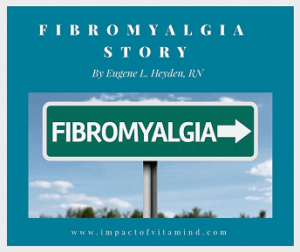Last update: 04/17/25
By Eugene L. Heyden, RN
“Vitamin D insufficiency is common; repletion of vitamin D to normal levels in patients who have chronic low back pain or have had failed back surgery may improve quality of life or, in some cases, result in complete resolution of symptoms.” ~Schwalfenberg, 2009, emphasis added
“Among these patients, severe musculoskeletal pain involving the low back, neck, shoulders, hips, and legs was refractory to opioid [narcotic] analgesic and nonsteroidal anti-inflammatory medications [NSAIDs] but resolved following vitamin D repletion.” ~Turner et al., 2008
“Up to 93% of patients with persistent pain have been reported to have hypovitaminosis D. Furthermore, vitamin D supplementation for 3 months resulted in pain resolution in 95% of patients with chronic low back pain in one study, and after 6 months, symptom resolution . . . among women with hypovitaminosis D in another study.” ~Atherton et al., 2009, emphasis added
———–
If you doubt whether a chronic low vitamin D status is a prevalent cause of severe back pain, I can straighten you out. I have several case reports on my desk, laid out before me; I am bent over (“Ouch!”) looking at them now—all are from reputable sources and available free online for all to read. They document substantial to complete resolution of low back pain in both young and elderly individuals after their low vitamin D levels were identified and corrected. The lesson they convey is clear: vitamin D deficiency can lead to devastating, drug-seeking, and narcotic-dependent back pain—the never-getting-better kind of life-dominating and life-destroying back pain, and back pain that vanished (or was significantly reduced) once vitamin D deficiency was corrected, often within a matter of weeks! These case reports include histories of failed back surgeries followed by successful surgeries once vitamin D repletion and bone healing were achieved. To keep things short and sweet, I will summarize ten cases, the results of which should remove all doubt about whether low vitamin D levels should be identified and corrected in patients with chronic back pain.
Case # 1
A 78-year-old patient with long-term back pain with an initial vitamin D level of 2.2 ng/mL. Back pain was resolved within 4 weeks after vitamin D was raised to 52 ng/mL. (Ghose, 2004a)A 78-year-old with long-term back pain had an initial vitamin D level of 2.2 ng/mL. Complete pain resolution occurred within 4 weeks after vitamin D was raised to 52 ng/mL. (Ghose, 2004a)
Case 2
An 86-year-old patient with 3 months of back pain and a history of lumbar compression fractures. Supplementation raised the patient’s vitamin D level from <5 ng/mL to 36 ng/mL, resulting in pain resolution after 3 weeks. (Ghose, 2004b)
Case 3
A 47-year-old individual with chronic back pain experienced a recurrence 6 months after disc surgery. The initial vitamin D level was estimated to be 28 ng/mL. With supplementation, pain resolved. The follow-up vitamin D level was 48 ng/ml. Pain recurred when supplementation stopped but resolved again after resumption. (Schwalfenberg, 2009)
Case 4
A 44-year-old patient with severe back spasms limiting activity had vitamin D levels raised from 19.6 ng/mL to 68.4 ng/mL with 5,000 IU/day of supplementation, leading to complete pain and back spasm resolution. (Schwalfenberg, 2009)
Case 5
A 30-year-old woman with chronic, disabling back pain that worsened after pregnancy experienced complete resolution when her vitamin D level was increased from 7.2 ng/mL to 28.8 ng/mL. (Schwalfenberg, 2009)
Case 6
A 63-year-old gentleman with a history of four back surgeries and a diagnosis of “failed back surgery.” He was receiving long-term disability benefits and attended a pain management clinic. He was, indeed, a train wreck! But this would all change. “His symptoms completely resolved after six weeks on 4,000 IU of vitamin D [per day] after years of having pain.” His initial vitamin D level was 8 ng/ml. After treatment, it rose to 34.8 ng/ml. (Schwalfenberg, 2009)
Case 7
A 46-year-old gentleman with chronic back pain following lumbar fusion required reoperation due to loose screws and soft bone. His initial vitamin D level was <4.8 ng/mL. After treatment, his vitamin D level rose to 50 ng/mL, and symptoms improved significantly. (Plehwe and Carey, 2002)
Case 8
A 46-year-old patient with 6 months of back pain radiating to both thighs, with a vitamin D level of 23 ng/mL. After 12 weeks of vitamin D supplementation (50,000 IU/week), the vitamin D level rose to 31 ng/mL, and the patient reported an 80% improvement in symptoms. (Cai, 2019)
Case 9
A 42-year-old lady with mid-to-lower back pain and scoliosis reported an 80% improvement after 6 weeks of 50,000 IU/week supplementation. Her initial vitamin D level was 22 ng/mL, rising to 32 ng/mL following treatment. Symptoms returned within a year due to noncompliance and her vitamin D level dropped to 14 ng/ml. “After taking 50,000 IU of vitamin D twice a week for 3 weeks, she reported 70% improvement of her symptoms. Retesting of vitamin D revealed a level of 29 ng/mL.” (Cai, 2019)
Case 10
A 41-year-old male patient with neck and upper back pain, limited cervical spine mobility, and occasional right arm weakness, with an initial vitamin D level of 27 ng/mL. After taking 3,200 IU/day of supplemental vitamin D, symptoms improved by 70% in 1 week and 90% in 10 weeks, with his vitamin D level rising to 36 ng/mL. (Cai, 2019)
Note: In the above case reports, I took the liberty of converting nmol/L to ng/mL where necessary. Since ng/mL is the laboratory value you will most likely see on a laboratory report, this conversion should help you better relate to the experiences of others.
The examples above illustrate what may be possible if vitamin D deficiency is identified and effectively treated in those experiencing chronic back pain. Of course, not every case will respond as in the above examples, but who knows how many will respond? One cannot dismiss the above case reports as merely an aberration, particularly in the context of the study I am about to relate.
In this study involving 360 chronic back pain patients, 83% had low vitamin D levels ranging from <4 ng/mL to 8.96 ng/mL. All participants received 5,000 to 10,000 IU of vitamin D supplementation daily after their initial evaluation. The results were striking: “341 patients (95%) reported disappearance of low back pain after vitamin D therapy” (Al Faraj and Al Mutairi, 2003). The study’s authors describe their findings as “a remarkable clinical and biochemical response to oral therapy with vitamin D.”
The study mentioned above occurred in sunny Saudi Arabia, where low vitamin D levels are common due to cultural practices and the fact that no one wants to be fried like an egg (or burned to a crisp) in the desert sun! It should be no surprise that pain sufferers do not typically engage in daytime outdoor activities. They spend their lives on the couch. They treasure the remote! They have watched every episode of Gilligan’s Island countless times! And, like the rest of us, they probably do not get enough vitamin D in their diet to compensate for the lack of vitamin D they would typically receive from regular sunlight exposure—who walking (or sitting) among us can eat 5 to 10 cans of tuna daily? The study’s authors close by saying: “Screening for vitamin D deficiency should be performed for all patients with chronic low back pain.” (Emphasis added) Have you been screened? Do you live a life in the shadows? Would you like to say goodbye to back pain?
[Adapted from The Impact of Vitamin D Deficiency]
Related Posts (Click image to open)
References
Al Faraj S, Al Mutairi K. Vitamin D deficiency and chronic low back pain in Saudi Arabia. Spine. 2003 Jan 15;28(2):177-9. https://journals.lww.com/spinejournal/abstract/2003/01150/vitamin_d_deficiency_and_chronic_low_back_pain_in.15.aspx
Atherton K, Berry DJ, Parsons T, Macfarlane GJ, Power C, Hyppönen E. Vitamin D and chronic widespread pain in a white middle-aged British population: evidence from a cross-sectional population survey. Annals of the rheumatic diseases. 2009 Jun 1;68(6):817-22. https://www.sciencedirect.com/science/article/abs/pii/S0003496724217465
Cai C. Treating vitamin D deficiency and insufficiency in chronic neck and back pain and muscle spasm: A case series. The Permanente journal. 2019;23. https://pmc.ncbi.nlm.nih.gov/articles/PMC6730953/
Ghose R. Osteomalacia: recovery of bone density. The New Zealand Medical Journal (Online). 2004a Jun 18;117(1196). https://www.proquest.com/openview/ba207ab2f879147e9e4790861e46279d/1?cbl=1056335&pq-origsite=gscholar
Ghose R. Sub-clinical osteomalacia. The New Zealand Medical Journal (Online). 2004b Aug 20;117(1200). https://www.proquest.com/openview/5013542500fc1d9dc6a1ce1783492208/1?cbl=1056335&pq-origsite=gscholar
Plehwe WE, Carey RP. Spinal surgery and severe vitamin D deficiency. The Medical journal of Australia. 2002 May 6;176(9):438-9. https://www.mja.com.au/journal/2002/176/9/spinal-surgery-and-severe-vitamin-d-deficiency
Schwalfenberg G. Improvement of chronic back pain or failed back surgery with vitamin D repletion: a case series. The Journal of the American Board of Family Medicine. 2009 Jan 1;22(1):69-74. https://www.jabfm.org/content/22/1/69.short
Turner MK, Hooten WM, Schmidt JE, Kerkvliet JL, Townsend CO, Bruce BK. Prevalence and clinical correlates of vitamin D inadequacy among patients with chronic pain. Pain Medicine. 2008 Nov 1;9(8):979-84. https://academic.oup.com/painmedicine/article-abstract/9/8/979/1856683
Copyright © 2025 Eugene L. Heyden, RN
All Rights Reserved

Disclaimer: This article is intended for educational purposes only. The information provided should not be considered medical advice or a substitute for the judgment and guidance of a qualified healthcare practitioner. While every effort has been made to ensure the accuracy and validity of the information presented, readers should evaluate the content in light of contrasting data, new research, and expert opinion. The author and publisher assume no responsibility for any errors, omissions, or misunderstandings arising from the information provided. The statements and opinions expressed have not been evaluated or approved by the Food and Drug Administration (FDA) or any other regulatory or authoritative body. Additionally, educational materials, websites, and other resources referenced in this article may change, become outdated, or become unavailable over time. The author and publisher make no guarantees regarding their accuracy, availability, or reliability. Neither the author nor the publisher shall be liable for any damages or consequences resulting from the reader’s use of the information provided.
DISCLAIMER: The book excerpts and articles featured on this website are offered solely for informational purposes. The information contained therein should be evaluated for accuracy and validity in the context of opposing data, new information, and the views and recommendations of a qualified health care professional, and not to be substituted for professional judgment and guidance or to provide a reason to neglect or delay appropriate medical care for self or for others. It is the reader and reader only who bears the responsibility for any actions that could be construed as being a response to the information presented. The statements and opinions expressed by the author or authors of the information provided on this website have not been reviewed or approved by the FDA or by any other authoritative body, nor is the author endorsing any product or specific therapy mentioned. The book excerpts, articles, statements, and opinions are offered to the reader to broaden his or her understanding of the issues discussed and to help identify options that may be suitable for the individual to pursue, on behalf of self or others, under approval and direction of a qualified physician or medical team member. All questions of a medical nature which arise from the book excerpts and articles available on this website should be directed at qualified health care professional.














